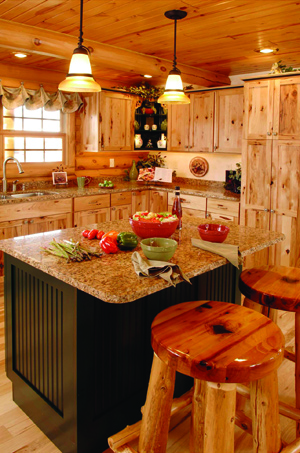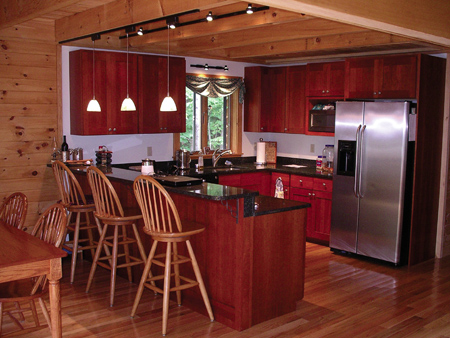No matter what floorplan you choose, you will need a kitchen. Here are ideas to consider when you are designing your brand-new log home kitchen.
Kitchens, like homes, reflect the personality of the person using them. When a homeowner answers the question of his or her basic needs, a design can take shape that fits that lifestyle.
“Survey your lifestyle. Ask: Who lives in the home?” says Stephanie Gauthier, interior designer for Wisconsin Log Homes in Green Bay, Wisconsin. “What are eating patterns? What type of room orientation do you want? Think about your lifestyle and combine it with the visual things you like.”
Here are simple questions to ask prior to the design process.
WHO is using the kitchen?
“Universal design” (design that is usable by as many people as possible) can accommodate lifestyle changes and make it functional for everyone for years to come.
Is the kitchen going to be used by two cooks? If so, consider two sinks, extra storage, extra workspace and plenty of walking space within the kitchen.
WHAT is the kitchen used for?
Cook or entertain a lot? Consider a large pantry for storage or add extra task space for food preparation. Pot filler faucets, undercounter wine cabinets, appliance drawers and warming drawers are popular, but do they fit your individual needs?
“Message centers are extremely popular,” says Stephanie. “There may be a mini office in the kitchen that includes space for organizing mail, the week’s events, to do lists, charging stations, or even Internet access for checking e-mail or looking up recipes.”

Golden Eagle Log Homes
WHERE is the kitchen located?
Need the garage close for easy transfer of groceries from the car to the fridge or pantry? Want the kitchen and great room in close proximity to ease socializing among the cook and guests?
Like to be outdoors? Quick access to an outdoor grilling or entertaining area can enhance your outdoor entertaining options.
WHEN do you use the kitchen?
Is the home a vacation getaway or one you will be at all the time? “The use of a kitchen in a primary home versus a secondary home is going to vary the type and amount of cooking that occurs,” Stephanie says.
Consider what type of lighting is necessary for when the kitchen is used, including ambient, task, and accent lighting. “Lighting is an area that people have a tendency to forget,” says Lynne Gastineau, president of Gastineau Log Homes in New Bloomfield, Missouri. “In kitchens, it’s important to think about zones. If you have a work space ‘zone,’ you might want to have an individual light switch for that area. If you have beams in the ceiling, you may want to angle lighting that shines up, off the cabinets, showing off the beams and keeping the area above from looking too dark.”
WHY do you need particular elements?
Energy Star® appliances, Water Sense-rated plumbing fittings, recycled materials, nongassing finishes, and LED lighting are “green” options that can also save you money.
One or two extra design features, such as glass cabinet doors or pull-out wastebaskets and recycling centers, can increase functionality without costing too much.
“Kitchen designs vary dramatically from one family to another because lifestyle plays a large role. Do you eat out a lot, entertain friends and family, or live far away from a shopping area? Homes today are designed not just for the homeowners, but their circle of friends,” Stephanie says.
HOW will you make it work?
Have you collected pictures or made sketches of what you like? Have you devised a budget? “Sometimes options selected are a matter of expense,” says Lynn. “If there are items in the kitchen that are easier to update later, price might be the consideration for choosing to hold off on those options.”

